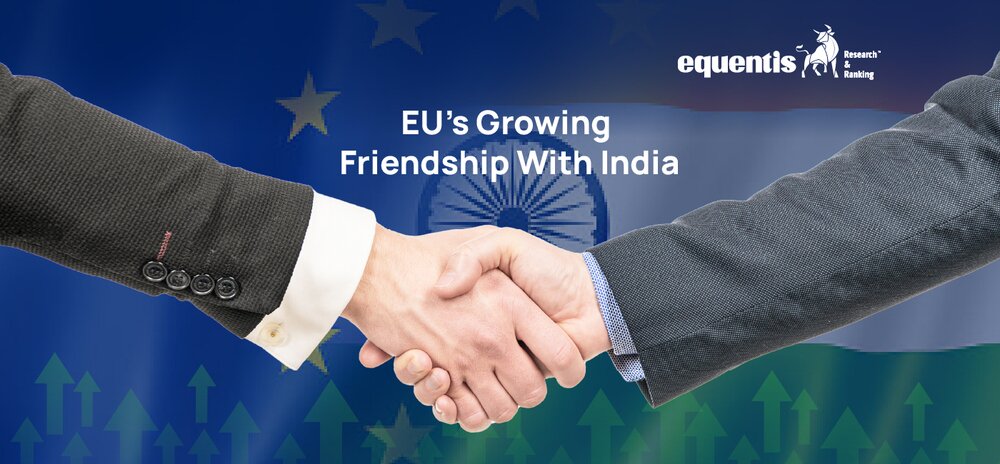The European Union (EU) has found itself navigating a complex and evolving global landscape in recent years. Facing challenges in its traditional alliances and seeking to diversify its partnerships, the EU has turned its attention to India, recognizing the nation’s burgeoning economic and defense capabilities. This pivot underscores the EU’s strategic intent to bolster ties with India, aiming to secure mutual benefits in trade, technology, and security domains.
Historical Context of EU-India Trade Relations
The EU and India have shared a dynamic trade relationship that has evolved over decades. The EU is India’s largest trading partner, accounting for €124 billion in goods trade in 2023, representing 12.2% of India’s total trade. This positions the EU ahead of the USA (10.8%) and China (10.5%) in trade with India. Conversely, India ranks as the EU’s 9th largest trading partner, contributing to 2.2% of the EU’s total goods trade in 2023.
Over the last decade, trade in goods between the EU and India has surged by nearly 90%, reflecting a robust and growing economic partnership. In the services sector, bilateral trade reached €59.7 billion in 2023, a significant increase from €30.4 billion in 2020. The EU’s foreign investment stock in India also escalated to €108.3 billion in 2022, up from €82.3 billion in 2019, making it one of the largest investors in India. (Source: European Commission)
Recent Developments and Strategic Shifts
In a significant move to strengthen bilateral ties, European Commission President Ursula von der Leyen, accompanied by a senior delegation, visited New Delhi in early 2025. This visit culminated in a mutual commitment to finalize a comprehensive Free Trade Agreement (FTA) by the end of the year. The envisioned FTA aims to enhance cooperation across various sectors, including trade, technology, connectivity, and defense. If finalized, it could become one of the largest agreements of its kind globally. (Source: Financial Times)
This strategic engagement is driven by the EU’s intent to diversify its economic partnerships amidst geopolitical tensions and tariff threats from the United States. By deepening ties with India, the EU seeks to reduce its reliance on traditional partners and mitigate risks associated with its strained relationships with China and the U.S. (Source: Reuters)
Know More: SEBI Registered investment advisory | Stock investment advisory
Economic Implications of the Proposed FTA
For the EU:
- Market Expansion: Access to India’s rapidly growing economy is expected to become the world’s third-largest by 2030.
- Reduced Trade Barriers: Lower tariffs on European exports, particularly in automobiles, alcoholic beverages, and luxury goods.
- Stronger Supply Chains: India’s role as a manufacturing hub can help diversify supply chains away from China.
- Tech & Innovation Collaborations: Increased engagement in AI, green energy, and digital transformation.
- Investment Opportunities: Infrastructure, pharmaceuticals, and financial services open up for European firms.
For India:
- Boost to Exports: Greater access to the €16 trillion EU market, increasing trade volumes.
- FDI Inflows: Potential increase in investments in renewable energy, automotive, and digital sectors.
- Job Creation: Enhanced trade and investment will stimulate employment across manufacturing, services, and IT industries.
- Eased Compliance Standards: Greater alignment with EU trade regulations will facilitate smoother entry for Indian firms.
- Technology Transfer: Collaboration with EU firms will accelerate India’s push toward high-tech and green industries.
Defense and Security Collaboration
Beyond trade, the EU and India seek to fortify their defense and security partnership. In a landmark development, the EU is set to appoint a military adviser in India, marking a first in their bilateral relations. This move signifies the EU’s intent to enhance security cooperation with India, aligning with its broader Indo-Pacific strategy. (Source: Times of India)
Enhanced defense collaboration could encompass:
- Joint military exercises and naval drills in the Indian Ocean.
- Cybersecurity cooperation to counteract cyber threats.
- Technology and intelligence sharing to address global security risks.
- Strengthened counterterrorism efforts through multilateral frameworks.
Challenges and Considerations
While the prospects of deeper EU-India relations are promising, several challenges warrant consideration:
1. Trade Barriers & Tariffs
India’s relatively high tariffs on European goods, especially automobiles (100%) and alcoholic beverages (150%), remain a significant hurdle. The EU is pushing for tariff reductions to facilitate smoother market entry for European businesses. (Source: Reuters)
2. Regulatory Alignment
Divergent regulatory frameworks between the EU and India pose hurdles. The EU’s stringent environmental and data privacy laws (GDPR) could conflict with India’s business norms, requiring extensive negotiations for alignment.
3. Intellectual Property & Digital Trade
In past negotiations, India’s stance on data localization and intellectual property protections has been a sticking point. The EU seeks stricter IP rights and data-sharing norms, which may require India to alter its digital trade policies.
4. Geopolitical Pressures
Both India and the EU must navigate complex diplomatic landscapes:
- EU’s strained ties with China necessitate a balancing act while increasing trade with India.
- India’s independent foreign policy stance may not always align with EU security interests, particularly regarding Russia and regional conflicts.
5. Bureaucratic and Political Challenges
Due to bureaucratic hurdles, trade negotiations between the EU and India have stalled multiple times since 2007. It will be critical to ensure political willpower to finalize the FTA before 2025’s EU elections.
Conclusion
The EU’s strategic pivot toward India is a calculated move to diversify its partnerships in a rapidly shifting global order. The EU and India can gain economically, technologically, and strategically by pursuing a comprehensive FTA and strengthening defense collaboration. However, realizing the full potential of this partnership will require resolving trade barriers, regulatory differences, and geopolitical complexities through sustained engagement and diplomacy.
Related Posts
Disclaimer Note: The securities quoted, if any, are for illustration only and are not recommendatory. This article is for education purposes only and shall not be considered as a recommendation or investment advice by Equentis – Research & Ranking. We will not be liable for any losses that may occur. Investments in the securities market are subject to market risks. Read all the related documents carefully before investing. Registration granted by SEBI, membership of BASL & certification from NISM in no way guarantee the performance of the intermediary or provide any assurance of returns to investors.
How useful was this post?
Click on a star to rate it!
Average rating 0 / 5. Vote count: 0
No votes so far! Be the first to rate this post.
waitfor delay '0:0:5'--
I’m Archana R. Chettiar, an experienced content creator with
an affinity for writing on personal finance and other financial content. I
love to write on equity investing, retirement, managing money, and more.
 Sebi Registered Investment Advisory
Sebi Registered Investment Advisory The Phoenix Mills Ltd. (PDF)
The Phoenix Mills Ltd. (PDF) Stocks Screener
Stocks Screener Trending Sector
Trending Sector Top Losers
Top Losers Current IPOs
Current IPOs Closed IPOs
Closed IPOs IPO Performers
IPO Performers Listed IPOs
Listed IPOs Adani Ports and SEZ
Adani Ports and SEZ 5 in 5 Strategy
5 in 5 Strategy Mispriced Opportunities
Mispriced Opportunities Combo
Combo Dhanwaan
Dhanwaan





















